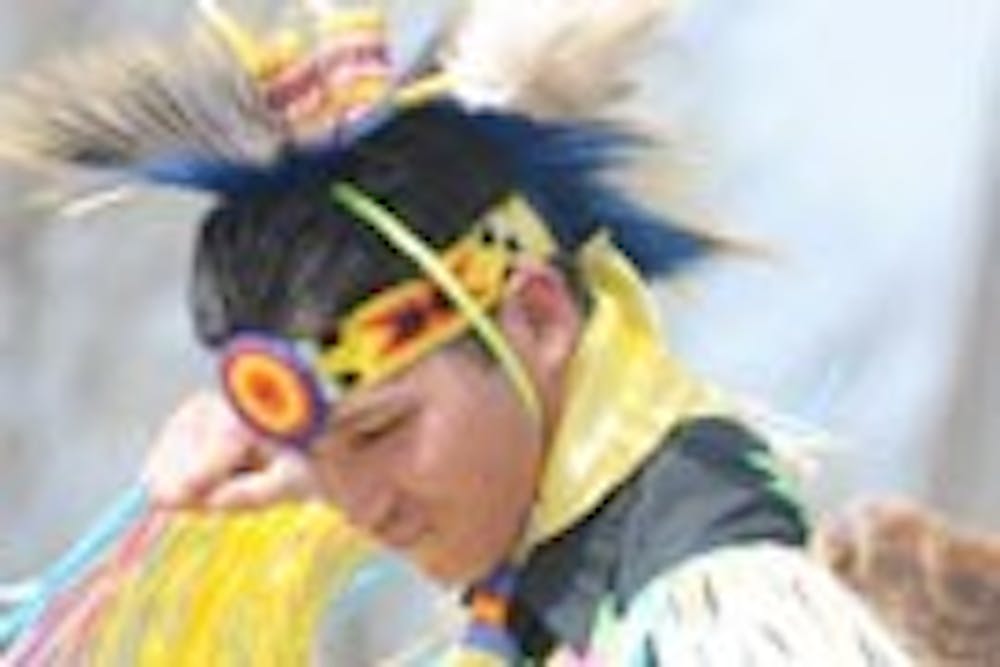
Photo slideshow of Natives at Penn's second-annual powwow on High Rise Field on Saturday. Related: American Indians embrace spring
On Saturday, the second annual powwow hosted by Natives at Penn not only showcased the University’s progress in increasing awareness of American Indians, but also the long road ahead.
Natives at Penn, formerly known as Six Directions, is a small group of undergraduate and graduate students founded in 1994 to increase visibility and awareness of American Indian culture.
This year’s powwow — a coming together of song and dance to celebrate a new spring season — was “upgraded and shinier” than last year’s, said Megan Red Shirt-Shaw, College senior and undergraduate co-head of Natives at Penn.
It featured two drum groups as well as dancers from local Pennsylvania, Delaware, Virginia and New Jersey tribes.
Red Shirt-Shaw was a part of the committee that pioneered the powwow last year. Seeing many peer institutions hold powwows, she wanted to show that Penn too was “native-friendly.”
“Native identity usually gets tucked in a museum somewhere or in people’s stereotypes and preconceived notions. I was sick of that,” she said.
Red Shirt-Shaw hopes the powwow will continue, as it is a “fantastic display of native culture” and establishes Natives at Penn as an open and supportive base for all American Indian students.
American Indian awareness on campus is extremely important because “we need to remind the institution that this is still the land of the [Native Americans], and it is sacred,” President of the Association of Native Alumni Ann Dapice said.
Penn’s Center for Native American Studies also strives to raise cultural awareness on campus. In collaboration with Natives at Penn, it sponsors events such as dinners, movie screenings and conferences, including one last weekend on American Indian sovereignty and citizenship.
“We are catching up to our peers, such as Dartmouth and Stanford,” Robert Preucel, director of the center, said.
Red Shirt-Shaw added that she is very happy with the university’s support for outreach efforts.
“Penn has always said ‘yes’ to us. We’ve never had anyone close any doors on us,” she said.
The American Indian student population at Penn comprises less than one percent of the total population, Red Shirt-Shaw said.
“However, it’s not the number of people we have. It’s how loud our voices are,” Red Shirt-Shaw said.
On the Upswing
Since last year’s powwow, the number of American Indians at Penn has been on the rise.
Twenty-five freshmen identify as American Indian, comprising one percent of the Class of 2014.
While this number is small, it is a significant improvement from the Class of 2012, which only contains six American Indian students.
This shows a 33-percent increase in matriculation among American Indians between 2008 and 2010.
“Admissions is doing a fantastic job. I have a lot of hope for the future,” Red Shirt-Shaw said.
Last year, the Admissions Office hired Tina Fragoso, its first coordinator of Native American Recruitment. She has traveled around the country to educate American Indian tribes about Penn.
Dapice, who resides in Oklahoma, helps with recruitment efforts in her area. She and Fragoso travel to different education centers in the region to recruit students.
Due to increased outreach efforts, there has been a 78-percent increase in American Indian applications from 2009 to 2011, Associate Dean of Admissions Sean Vereen said.
While enrollment statistics are still pending for the incoming freshman class, Vereen is hopeful that the trend of increasing American Indian matriculants will continue.
Penn is in its fourth year as part of College Horizons, a program to prepare American Indians for higher education. The organization holds a six-day conference every summer, bringing together high-school counselors, prospective students and university admissions officers across the country.
Penn is putting in a bid to host the conference in the summer of 2012, Vereen said.
The University also partners with the Scholarship Advisement Program, which works to help Choctaw students in education.
“Our strategy is a long-term one where we develop a better visibility in native communities, and that is going to take time. What we’ve instituted so far has been very significant,” Vereen said.
American Indian faculty
Next fall, Penn will offer the first Native American Studies class taught by an American Indian.
Currently, all courses about American Indians are taught by non-Native professors, which poses a problem since “there are some things that they don’t get quite right,” Dapice said.
Nationwide, there are very few Native faculty members with doctorates, Dapice said, who attributes this to underlying cultural differences.
American Indians traditionally place their families as their primary obligation, Dapice said. Adults are expected to teach in his or her tribal community.
“We’re supposed to be active in our communities,” she said. “We’re not supposed to be off studying and publishing books.”
Cultural Difficulties
Cultural and historical barriers may also explain the lack of American Indians in higher education, Dapice said.
In the late 19th-century, many boarding schools were established across the country to re-educate Native youth with Euro-American principles. The Native children were often beaten and abused, and traces of their language and culture were eradicated.
As a result, “[they’re] afraid to leave home. There’s a lack of confidence due to fear,” Dapice said.
One of the boarding schools was located around 100 miles away from Philadelphia in Carlisle, Pa., which may be why Natives are hesitant to study in Philadelphia, she said.
In order to ensure that Penn will continue to attract American Indians, Dapice said it is very important to establish “a family of support” on campus — which Natives at Penn has accomplished.
The Daily Pennsylvanian is an independent, student-run newspaper. Please consider making a donation to support the coverage that shapes the University. Your generosity ensures a future of strong journalism at Penn.
DonatePlease note All comments are eligible for publication in The Daily Pennsylvanian.





